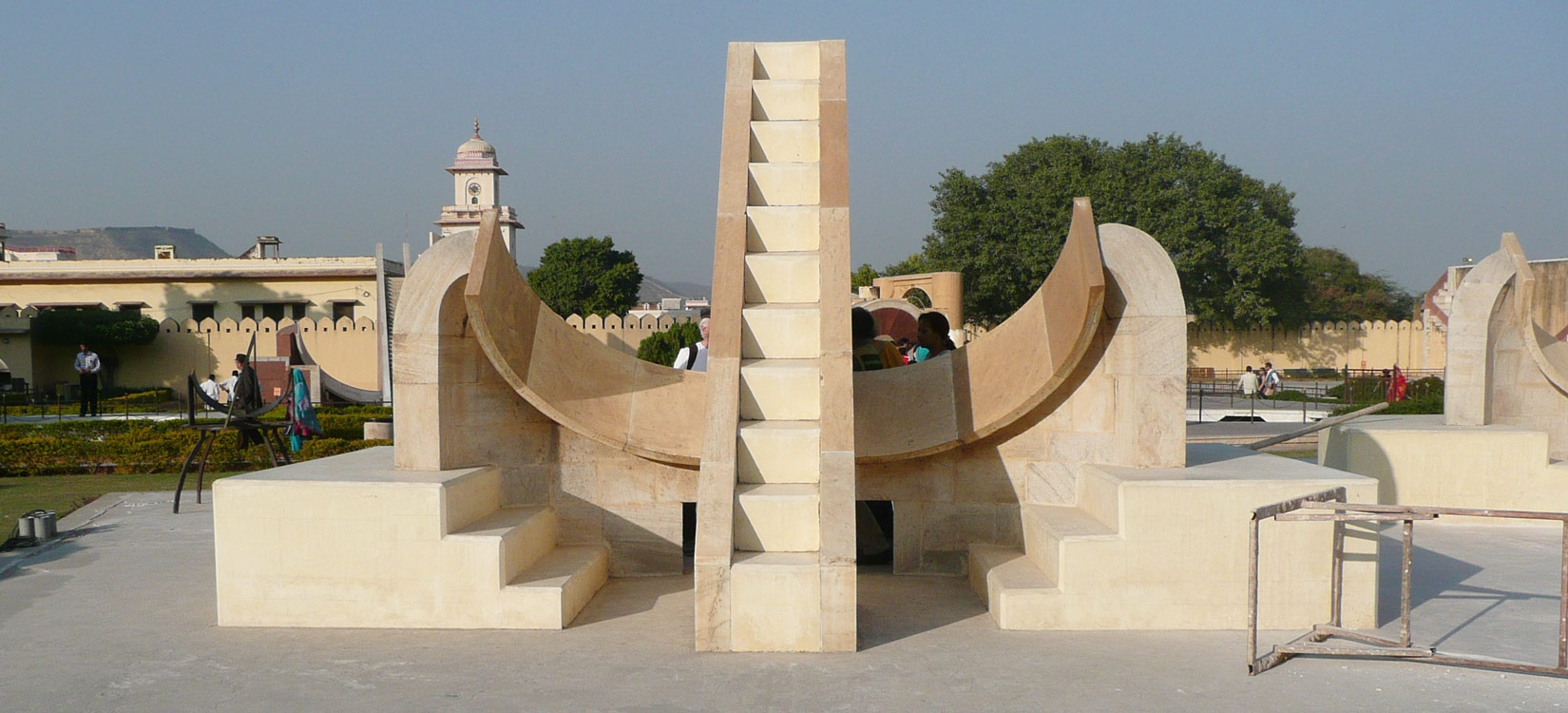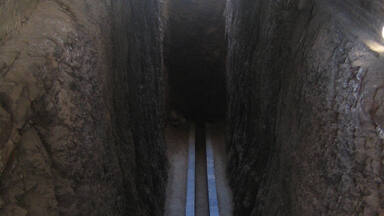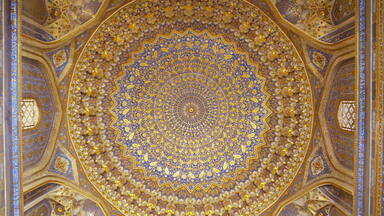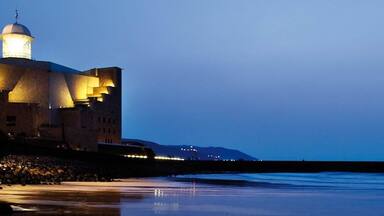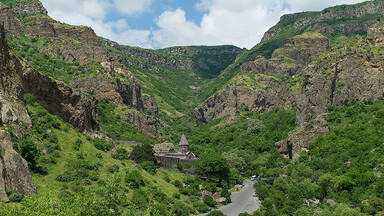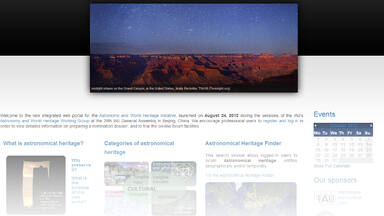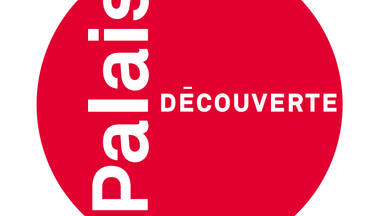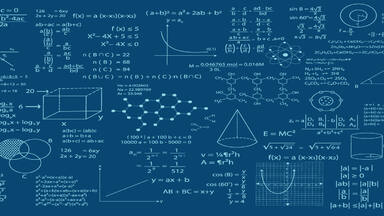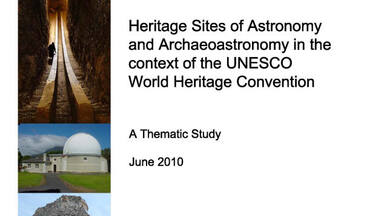Created in 2003 within the framework of the Global Strategy for the balanced, representative and credible World Heritage List, as a pilot activity for the identification of the sites connected with astronomy, the Thematic Initiative on Astronomy and World Heritage, aims to establish a link between Science and Culture towards recognition of the monuments and sites connected with astronomical observations dispersed throughout all the geographical regions, not only scientific but also the testimonies of traditional community knowledge.
This Initiative offers to the States Parties a possibility to evaluate and recognize the importance of this specific heritage, in terms of enrichment of the history of humanity, the promotion of cultural diversity and the development of international exchanges. It provides an opportunity not only to identify the sites connected with astronomy but also of keeping their memory alive and preserving them from progressive deterioration, through the through inscription on the World Heritage List of the most representative properties.
Table of contents
Why "Astronomy" and "World Heritage"
The sky, our common and universal heritage, forms an integral part of the total environment that is perceived by mankind. Including the interpretation of the sky as a theme in World Heritage is a logical step towards taking into consideration the relationship between mankind and its environment. This step is necessary for the recognition and safeguarding of cultural properties and of cultural or natural landscapes that transcribe the relationship between mankind and the sky.
Properties relating to astronomy stand as a tribute to the complexity and diversity of ways in which people rationalised the cosmos and framed their actions in accordance with that understanding. This includes, but is by no means restricted to, the development of modern scientific astronomy. This close and perpetual interaction between astronomical knowledge and its role within human culture is a vital element of the outstanding universal value of these properties. These material testimonies of astronomy, found in all geographical regions, span all periods from prehistory to today.
Implementation activities
The first international experts meeting on scientific and astronomical heritage organized by the World Heritage Centre in collaboration with the UNESCO Venice Office and the support of the Government of the United Kingdom, was held in Venice, Italy (17-19 March 2004). The main goal of the meeting was to define the strategy of the thematic initiative and a methodology which will aid States Parties in identification of the sites connected with astronomy. The results of this activity, including the thematic project “Astronomy and World Heritage” was presented during the 28th session of the World Heritage Committee.
In 2004, the World Heritage Committee at its 28th session (Decisions 28 COM 9, para. 6 , Suzhou, China) requested the World Heritage Centre to submit, for its consideration at its 29th session, the Thematic Initiative of the World Heritage Centre on “Astronomy and World Heritage”.
In 2005, the World Heritage Committee at its 29th session (Decision 29 COM 5B , Durban, South Africa) requested the Director of the World Heritage Centre to further explore the Thematic Initiative “Astronomy and World Heritage” as a means to promote, in particular, nominations which recognize and celebrate achievements in science. This Thematic Initiative including UNESCO’s Astronomy and World Heritage Timeframe were presented at the International Symposium organised by the Institute of Astronomy of Russian Academy of Sciences, held in June 2005 in Moscow (Russian Federation).
In 2007, during the celebration of the 50th anniversary of the Sputnik organized by ESA/CNES , the World Heritage Centre launched a new research proposal « Odyssey of human creative genius: towards protection of space technological heritage connected with space exploration ».
In 2008, the World Heritage Committee at its 32nd session (Quebec City, 2008) examined the Integrated Implementation Strategy of the Thematic Initiative “Astronomy and World Heritage” (document WHC-08/32.COM/INF.5C , Decision 32 COM 5). This strategy, prepared in coordination with the National Focal Points in charge of the implementation of the Initiative, Advisory Bodies and the International Astronomical Union (IAU), aims to improve the identification, conservation and management of the specific types of properties connected with astronomical observations and traditional astronomical knowledge.
In October 2008, UNESCO signed a Memorandum of Understanding with the International Astronomical Union (IAU) as a result of which the IAU has become integrally involved in the process of advancing the initiative. One of the first actions of the IAU was to set up a Working Group on Astronomy and World Heritage, which has since become its Commission C4 on World Heritage and Astronomy. For more information on its activities visit the Commission's website at www.astronomicalheritage.org.
In order to facilitate the identification and nomination process of astronomical sites, a cycle of activities Astronomy and World Heritage: across time and continents was launched by the Director-General of UNESCO in 2009 during the opening ceremony of the International Year of Astronomy “ The Universe, Yours to Discover ”.
In order to raise the credibility of the World Heritage Convention, numerous events were organized by the States Parties, in coordination with the World Heritage Centre and Advisory Bodies, in 2009 and early 2010. The main activities were the following: an International Youth Summer Camp on Astronomy and World Heritage , organized by the WHITR-AP Suzhou Centre (Suzhou, China, July 2009), an International Conference on "Astronomy and World Heritage: across time and continents" organised and hosted by the Russian Federation (Kazan, Republic of Tatarstan, August 2009), and an International Seminar on Astronomical Heritage organized by the Egyptian National Commission for UNESCO, with support of the World Heritage Funds (Cairo, Egypt, February 2010).
In 2010, the Committee at its 34th session (Decision 34 COM 5F.1 , Brasilia, 2010) requested the World Heritage Centre to disseminate among the States Parties the first Thematic Study on Astronomical Heritage jointly prepared by ICOMOS and the International Astronomical Union (IAU) Working Group, in line with Decision 32 COM 10A (Quebec City, 2008) and within the framework of the Integrated Implementation Strategy of this Initiative. A second Statement of Working Methods and Formal Processes for the Implementation of Activities was established within the framework of the Memorandum of Understanding between UNESCO and IAU extended in October 2010.
At its 34th session (Brazil, July 2010), the World Heritage Committee inscribed on the World Heritage List two properties connected with astronomy:
- the Jantar Mantar, Jaipur (India) , an astronomical observation site built in the early 18th century comprising 19 large instruments for naked-eye observation. This represents one of the most complete and impressive collections in the world of telescopic masonry instruments in functioning condition;
- the 13th-century Dengfeng Observatory in China, inscribed as one of the components of the Historic Monuments of Dengfeng in “The Centre of Heaven and Earth” (China). This extraordinary horizontal gnomon and 31m-long measuring scale was used for accurately measuring the length of the sun's noontime shadow, and hence for determining the length of the tropical year and the curvature of the earth.
In 2011, the World Heritage Committee at its 35th session (Decision 35 COM 9C , UNESCO, Paris) encouraged States Parties to take into account the recommendations provided by the Science and Technology Expert Working Group in the context of World Heritage Nominations (London, 2008), as well as recommendations developed within the framework of the Thematic Initiative “Astronomy and World Heritage” while preparing nominations to the World Heritage List.
In 2011-2012, the network of partners was reinforced, international efforts to recognize astronomical heritage were coordinated, a new transnational project “Route of European Observatories” was initiated by the French authorities, a new project proposal on Space Technological Heritage was launched by the Russian authorities and the “Paris Declaration on astronomical heritage” was adopted by the participants during the International Seminar ”Protection of Heritage of Astronomy” (Paris, September 2011) .
At its 36th Session (St. Petersburg, 2012), the World Heritage Committee welcomed financial and technical support provided by States Parties and the International Astronomical Union for the Thematic Initiative “Astronomy and World Heritage”, since 2003 and also encouraged cooperation between the UNESCO World Heritage Centre, specialized agencies and relevant interdisciplinary scientific initiatives towards the elaboration of a Global Thematic Study on Heritage of Science and Technology, including studies and research on technological heritage connected with space exploration. The Committee further encouraged States Parties, international organizations and other donors to contribute to the thematic programmes and initiative and also requested an updated report on Thematic Programmes to the World Heritage Committee at its 38th session in 2014.
The WHC informed the States Parties by a circular letter CL/WHC-12/14/AWH/AS ( restricted access only for the States Parties) on the implementation of the World Heritage Committe decision 36.COM/5D adopted at its 36th Session.
In 2015, the IAU organised a side-event on “The Astronomy and World Heritage Initiative, Achievements and Issues” at the 2015 World Heritage Committee meeting (39 COM) in Bonn, Germany; a Focus Meeting on “Astronomical Heritage: Progressing the UNESCO–IAU Initiative”, held at the IAU General Assembly in Honolulu, Hawai‘i, USA; and an international meeting on “Hawaiian, Oceanic and Global Cultural Astronomy: Tangible and Intangible Heritage”, held in Hilo, Hawai‘i, USA.
Portal to the Heritage of Astronomy
The Portal to the Heritage of Astronomy has been developed in partnership with the World Heritage Centre to support UNESCO's Thematic Initiative “Astronomy and World Heritage”. It exists to raise awareness of the importance of astronomical heritage worldwide and to facilitate efforts to identify, protect and preserve such heritage for the benefit of humankind, both now and in the future. The public launch of this portal took place at the 28th IAU General Assembly in Beijing, China, on 24 August 2012.
Visit Portal to the Heritage of Astronomy
Thematic Studies
Two Thematic Studies jointly prepared by ICOMOS and the International Astronomical Union (IAU) Commission C4 constitute the background for a comparative analysis that could be carried out to assess the Outstanding Universal Value of a specific site of the same type proposed for World Heritage listing.
The first Thematic Study (2010):
- identifies the main characteristics and astronomical values of the generic type of heritage site from a World Heritage perspective;
- examines a select number of representative examples included or not included in the World Heritage List;
- determines possible gaps in the latter and, with reference to the Operational Guidelines; and
- indicates the criteria under which such sites might be nominated for inscription on the World Heritage List.
The second Thematic Study (2017):
- explores in more detail some of the unresolved issues raised in the first, using case studies structured in the form of segments of draft dossiers;
- provides help and guidance relating to properties that might have a strong claim for inclusion on national tentative lists;
- provides guidance for State Parties and stakeholders where it is considered that the property might have the capacity to demonstrate OUV; and
- considers dark sky qualities in detail, concluding that, while dark sky places cannot, in themselves, be recognized as specific types or categories of World Heritage property, either cultural or natural, dark sky values can nonetheless enhance either the natural or cultural value of a place (or both), and in this sense contribute to potential OUV.
Read more about the first Thematic Study (2010)
Read more about the second Thematic Study (2017)
Download and Read the Thematic Studies
Statement concerning dark skies and celestial objects
Taking into account the growing number of requests to UNESCO concerning the recognition of the value of the dark night sky and celestial objects, the World Heritage Centre made its first statement in 2007 underlining that the sky or the dark night sky or celestial objects or starlight as such cannot be nominated to the World Heritage List within the framework of the Convention concerning the Protection of the World Cultural and Natural Heritage.
The World Heritage Centre wishes to underline that the « Starlight » Initiative developed by a group of international experts is not part of the UNESCO Thematic Initiative "Astronomy and World Heritage ».
The World Heritage Centre has been informed that during the « Starlight » Initiative's meeting in 2009 that the Working Group "Starlight Reserves and World Heritage" developed a concept "Starlight Reserve". The ICOMOS-International Astronomical Union Global Thematic Study on Astronomical Heritage includes a study on "Starlight Reserve" proposal.
However, neither Starlight Reserves, nor Dark Sky Parks can be recognized by the World Heritage Committee as specific types or categories of World Heritage cultural and natural properties since no criteria exist for considering them under the World Heritage Convention.
Meetings
2015
- Focus Meeting on “Astronomical Heritage: Progressing the UNESCO–IAU Initiative”, held at the 2015 IAU General Assembly, Honolulu, Hawai‘i, USA, 11–13 August 2015
- International meeting on “Hawaiian, Oceanic and Global Cultural Astronomy: Tangible and Intangible Heritage”, held in Hilo, Hawai‘i, USA, 16–20 August 2015
2011
- International Seminar ”Protection of Heritage of Astronomy”
- Paris, France, September 2011
2010
- International Seminar on Astronomical Heritage,
- Cairo, Egypt, February 2010
2009
- Edizione 2009 del Colloquium Daniel Chalonge (Scuola Internazionale di Astrofisica de l’l’Observatoire de Paris), Torino Palazzo Lascaris 21-24 ottobre 2009
- Joint Symposium: Astronomy and its instruments before and after Galileo, 28 September – 3 October 2009, Venice, Italy
- International conference: Astronomy and World Heritage: Across Time and Continents, Kazan, Republic of Tatarstan, Russian Federation, August 19, 2009 - Aug 24, 2009
- International Workshop and Expert Meeting on Starlight Reserves and World Heritage held in Fuerteventura, Spain March 16, 2009
- Symposium: The Role of Astronomy in Society and Culture January 19, 2009 - January 23, 2009
2008
- Science and Technology Expert Working Group in the context of World Heritage Nominations , London, 2008
- International ICOMOS Symposium Cultural Heritage of Astronomical Observatories : From Classical Astronomy to Modern Astrophysics , Hamburg, Germany, October 14–17, 2008
2007
- Celebration of the 50th anniversary of the Sputnik organized by ESA/CNES, Paris, 2007
- Starlight Conference u nder the Honorary Presidency of H.R.H. Felipe de Borbón Prince of Asturias , Teatro Chico, Santa Cruz de La Palma, Spain , April 2007
2005
- International Symposium, Institute of Astronomy of Russian Academy of Sciences, Moscow, Russian Federation, June 2005
2004
- First international experts meeting on scientific and astronomical heritage , Venice, March 2004
References
Books and Proceedings
- Heritage Sites of Astronomy and Archaeoastronomy in the Context of the World Heritage Convention: Thematic Study no. 2, edited by Clive Ruggles, ICOMOS–IAU, June 2017.
- Proceedings of the Focus Meeting on “Astronomical Heritage: Progressing the UNESCO–IAU Initiative”, in Astronomy in Focus, edited by Piero Benvenuti, Cambridge University Press, 2016, pp. 77–153.
- Heritage Sites of Astronomy and Archaeoastronomy in the Context of the UNESCO World Heritage Convention: A Thematic Study, edited by Clive Ruggles and Michel Cotte, ICOMOS–IAU, June 2010
- Starlight: A Common Heritage, edited by Cipriano Marín and Jafar Jafari, Starlight Initiative, March 2009.
- Cultural Heritage of Astronomical Observatories from Classical Astronomy to Modern Astrophysics, Proceeedings of the International ICOMOS Symposium in Hamburg, Germany, October 14–17, 2008, edited by Gudrun Wolfschmidt, ICOMOS, 2009.
Articles
- “World Heritage and the protection of working observatory sites”, in Piero Benvenuti (ed.), Astronomy in Focus: As presented at the IAU XXIX General Assembly, 2015 (Proceedings of the International Astronomical Union XXIXA), Cambridge University Press (2016), pp. 463–472.
- “A iniciativa UNESCO–IAU “Astronomia e Patrimônio Mundial”: sucessos, temas e prospecções”, in Priscila Faulhaber and Luiz C. Borges (eds), Perspectivas etnográficas e históricas sobre as astronomias, Museu de Astronomia e Ciências Afins—MAST, Rio de Janeiro (2016), pp. 7–17.
- “Astronomy and world heritage activities”, in Thierry Montmerle (ed.), IAU Information Bulletin no. 111, International Astronomical Union, Paris (2013), pp. 28–30.
- “Astronomy and World Heritage”, in Ian F. Corbett (ed), Highlights of the XXVII IAU General Assembly, August 2009, Proceedings of the International Astronomical Union, 6 (Transactions T27B), IAU (2010), pp. 12–17.
- “From Stone Age to Space Age: Astronomy & World Heritage Thematic Studyreleased”, IAU Press Release 1006, 6 August 2010
- World Heritage Review n°54dedicated to the Initiative “Astronomy and World Heritage”.
- UNESCO World Heritage Centre
First international experts’ meeting on scientific and astronomical heritage
World Heritage Newsletter N° 44, April - May 2004, p. 4. - UNESCO World Heritage Centre
Archaeo-Astronomical Sites and Observatories
World Heritage Newsletter N° 42, November – December 2003 / January 2004, p. 3.
Décisions / Résolutions (6)
Le Comité du patrimoine mondial,
1. Ayant examiné le document WHC-11/35.COM/9C,
2. Rappelant les décisions 31 COM 9 et 32 COM 10A adoptées respectivement à ses 31e (Christchurch, 2007) et 32e (Québec, 2008) sessions,
3. Prend note des informations fournies sur les recommandations du groupe d'experts sur la science et technologie dans le contexte des propositions d'inscriptions sur la Liste du patrimoine mondial (Londres, 2008) et des discussions ultérieures sur les révisions des Orientations ;
4. Prend note en outre de l'achèvement de l'étude thématique sur le thème «Les sites du patrimoine de l'astronomie et de l'archéoastronomie dans le cadre de la Convention du patrimoine mondial de l'UNESCO» et des progrès réalisés concernant l'étude sur «La gestion du patrimoine de l'eau» ;
5. Encourage les États parties à prendre en compte les recommandations fournies par le groupe d'experts sur la science et la technologie dans le contexte des propositions d'inscriptions sur la Liste du patrimoine mondial (Londres, 2008), ainsi que des recommandations élaborées dans le cadre de l'Initiative thématique «Astronomie et patrimoine mondial» tout en préparant des propositions d'inscription sur la Liste du patrimoine mondial et demande le Centre du patrimoine mondial et les Organisations consultatives d'intégrer les questions pertinentes à la future réunion d'experts sur le critère (vi);
6. Encourage également les États parties et les donateurs d'identifier les ressources supplémentaires pour la finalisation, la publication et la diffusion des études thématiques.
En savoir plus sur la décisionLe Comité du patrimoine mondial,
1. Ayant examiné les documents WHC-10/34.COM/5F , WHC-10/34.COM/INF.5F.1 et WHC-10/34.COM/INF.5F.2 ,
2. Prend note , avec satisfaction, des progrès accomplis dans la mise en oeuvre des Programmes thématiques du patrimoine mondial ;
3. Félicite l'importante contribution du groupe de travail scientifique international, des États parties et des Organisations consultatives dans le développement du Programme thématique du patrimoine mondial sur la préhistoire et approuve la suggestion émanant du groupe de rédaction de renommer le Programme thématique du patrimoine mondial sur la préhistoire Evolution de l'Homme : adaptations, dispersions et développements sociaux (HEADS, Human Evolution : adaptations, dispersals and social developments).
4. Prend également note des activités organisées par les États parties dans le cadre de l'Initiative thématique "Astronomie et patrimoine mondial" et demande au Centre du patrimoine mondial de diffuser parmi les États parties l'étude thématique sur le patrimoine astronomique préparée conjointement par le groupe de travail de l'ICOMOS et l'Union astronomique internationale, en conformité avec sa décision 32 COM 10A ;
5. Note les activités entreprises afin de progresser dans la mise en oeuvre du cadre du Programme marin du patrimoine mondial et le Plan d'action du Bahreïn et remercie les États parties concernés, l'UICN et le Centre du patrimoine mondial pour leur implication jusqu'à présent ;
6. Remercie également les États parties ayant soutenu la mise en oeuvre des programmes thématiques du patrimoine mondial ;
7. Prend note en outre , en particulier de la contribution des autres programmes thématiques et initiatives du patrimoine mondial à la mise en oeuvre de ses objectifs stratégiques et demande également au Directeur du Centre du patrimoine mondial d'identifier des fonds extrabudgétaires et d'assurer les ressources humaines adéquates pour leur développement continu portant sur des questions clé de conservation du patrimoine mondial;
8. Note également l'inquiétude exprimée concernant la nécessité de faire des économies d'échelle, en particulier pour les PEID, et prend cela en considération lors de l'exécution de ces programmes ;
9. Demande en outre au Centre du patrimoine mondial de présenter un rapport actualisé sur les programmes thématiques à sa 36e session en 2012.
En savoir plus sur la décisionLe Comité du patrimoine mondial,
1. Ayant examiné le document WHC-08/32.COM/10A,
2. Rappelant les décisions 31 COM 13 et 31 COM 17 adoptées à sa 31e session (Christchurch, 2007),
3. Remerciant le gouvernement du Royaume-Uni d'avoir accueilli la réunion d'experts sur la Science et la Technologie qui s'est tenue du 21 au 23 janvier 2008 à Londres, ainsi que les experts qui y ont contribué,
4. Prenant note des résultats et recommandations de la Réunion d'experts sur la science et la technologie dans le cadre de la Stratégie globale,
5. Prend note du rapport d'avancement sur les études thématiques globales entreprises par l'ICOMOS et l'UICN ;
6. Demande à l'UICN et à l'ICOMOS de continuer à développer leurs travaux sur les études thématiques, en tenant compte des priorités identifiées dans le document WHC-08/32.COM/10A ;
7. Notant l'insuffisance du financement de cette activité importante pour l'identification de biens ayant ou possédant une valeur universelle exceptionnelle potentielle ;
8. Prend note du besoin de ressources supplémentaires à octroyer pour financer les travaux prioritaires de l'UICN et de l'ICOMOS sur les études thématiques, y compris la mise à jour des études existantes, l'application du critère vii et les nouvelles initiatives, et d'en promouvoir l'utilisation effective par les États parties ;
9. Invite les États parties à la Convention à envisager une assistance extrabudgétaire pour soutenir les travaux mentionnés aux paragraphes 6 et 7 ci-dessus ;
10. Remercie le gouvernement français pour sa généreuse offre de financement d'une étude thématique sur les paysages culturels de l'agropastoralisme ;
11. Remercie le gouvernement espagnol pour sa généreuse offre de financement d'une étude thématique sur les sites préhistoriques.
En savoir plus sur la décisionLe Comité du patrimoine mondial,
- Ayant examiné les documents WHC-08/32.COM/5, WHC-08/32.COM/INF.5A et WHC-08/32.COM/INF.5C,
- Rappelant la décision 31 COM 5.1, adoptée à sa 31e session (Christchurch, 2007),
- Prend note avec satisfaction des résultats des activités entreprises l'an passé par le Centre du patrimoine mondial dans le cadre de ses cinq Objectifs stratégiques, et en particulier du travail en cours pour intégrer pleinement les communautés locales dans tous les aspects de la conservation et de la gestion des sites du patrimoine mondial ;
- Note avec satisfaction les résultats des activités que l'UICN, l'ICOMOS et l'ICCROM ont menées l'an passé pour soutenir la mise en oeuvre de la Convention ;
- Note en outre que plusieurs nouveaux problèmes sont apparus en ce qui concerne la charge de travail, les ressources disponibles, la gouvernance et les futurs enjeux pour le fonctionnement du Comité du patrimoine mondial et de la Convention du patrimoine mondial, qui bénéficieraient d'un examen approfondi fondé sur les conclusions des travaux préliminaires, pour discussion à la 33e session du Comité du patrimoine mondial ;
- Demande au Centre du patrimoine mondial de présenter à la 33e session du Comité du patrimoine mondial un état récapitulatif des questions traitées durant l'année et des recommandations pour améliorer le travail du Centre, à soumettre à l'examen du Comité.
Le Comité du patrimoine mondial,
1. Ayant étudié l’annexe 1 du document WHC-05/29.COM/5,
2. Approuve le Programme du patrimoine mondial pour les petits États insulaires en développement (PEID) et le Programme marin du patrimoine mondial ;
3. Demande au Directeur du Centre du patrimoine mondial d’étudier plus avant l’initiative thématique « Astronomie et patrimoine mondial », en tant que moyen de promouvoir, en particulier, les propositions d’inscription qui reconnaissent et célèbrent des avancées scientifiques ;
4. Approuve un budget biennal de 20.000 dollars EU pour le Programme du patrimoine mondial pour les petits États insulaires en développement et de 50.000 dollars EU pour le Programme marin du patrimoine mondial, à financer par le biais du Fonds du patrimoine mondial, comme proposé dans le document WHC-05/29.COM/16.
En savoir plus sur la décisionLe Comité du patrimoine mondial,
1. Prenant note du rapport du Centre du patrimoine mondial présenté dans la partie I du document WHC-04/28.COM/9 Rev,
2. Rappelant les décisions 27 COM 4 et 27 COM 5.1, ainsi que la nécessité de tenir le Comité informé de la mise en oeuvre de ses décisions,
3. Prend note avec satisfaction de l’activité spéciale d’aide au patrimoine mondial en République démocratique du Congo ; Décisions adoptées lors de la 28e session du Comité WHC-04/28.COM/26, p. 4 du patrimoine mondial (Suzhou, 2004)
4. Exprime sa vive inquiétude devant le manque critique de personnel permanent au Centre du patrimoine mondial, - en particulier dans les unités Amérique latine et Caraïbes, Europe et Amérique du Nord et l’unité de Politique générale et réunions statutaires - , ce qui a des effets majeurs sur les responsabilités du Centre du patrimoine mondial en tant que Secrétariat de la Convention du patrimoine mondial, et considère qu’il faut s'occuper de toute urgence de ce manque de personnel et, au plus tard, pour l’exercice biennal 2006-2007, dans le cadre du Programme et Budget de l’UNESCO ;
5. Prend note de la proposition de base de données en ligne pour la mise en oeuvre des décisions du Comité, présentée dans la Partie II du document WHC-04/28.COM/9 Rev ;
6. Demande au Centre du patrimoine mondial de soumettre pour considération à sa 29e session (2005) les initiatives thématiques du Centre du patrimoine mondial intitulées « Astronomie et patrimoine mondial » et « Conservation du milieu marin » ;
7. Décide que le Centre du patrimoine mondial finalisera et soumettra à l’approbation de la Présidente de la 27e session du Comité (2003) les Orientations révisées pour la mise en oeuvre de la Convention du patrimoine mondial, telles qu’adoptées à sa 6e session extraordinaire (2003). Les Orientations révisées seront appliquées, si finalisées, à compter du 1er novembre 2004, avec des arrangements transitoires appropriés dans les cas indiqués. En particulier, les propositions d'inscription soumises pour examen par le Comité à sa 30e session en juillet 2006 seront examinées et évaluées conformément aux Orientations de 2002. De plus, le Président de la 27e session du Comité est autorisé à inclure les observations faites par le Comité durant sa 28e session ;
8. Demande également au Centre du patrimoine mondial de lui présenter à sa 29e session (2005) un compte rendu sur la base de données en ligne, étant entendu que cette base de données deviendra opérationnelle à compter du 1er avril 2005 et qu’elle contiendra des informations sur la mise en oeuvre des décisions adoptées à toutes ses réunions, ordinaires et extraordinaires, depuis la 26e session (2002) ;
9. Demande en outre au Centre du patrimoine mondial de mettre au point une base de données semblable pour les décisions adoptées par l’Assemblée générale des États parties à la Convention du patrimoine mondial et de lui en rendre compte à sa 29e session (2005).
En savoir plus sur la décision